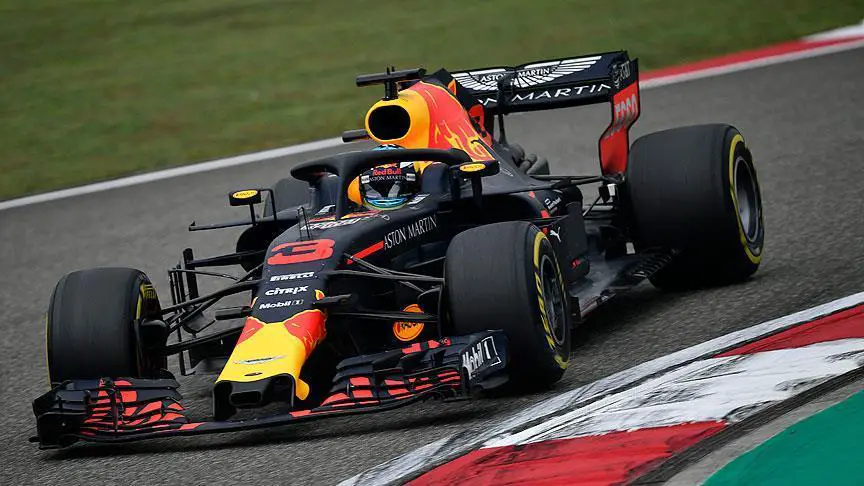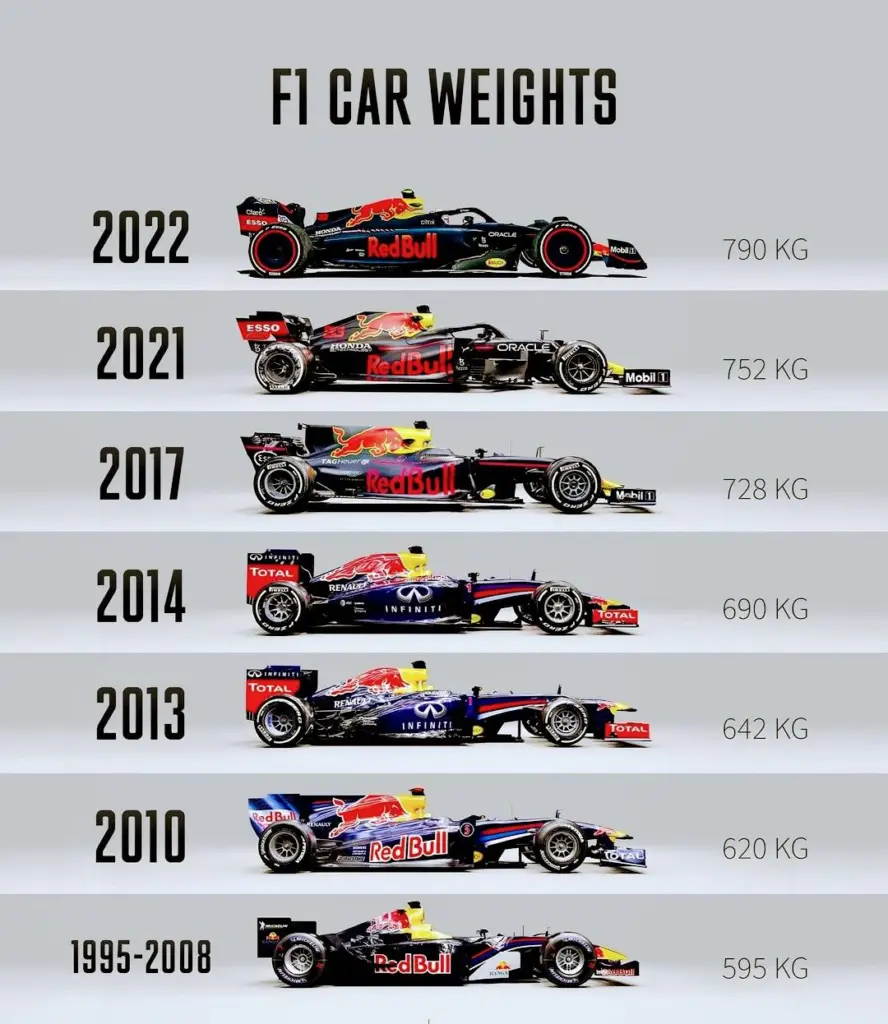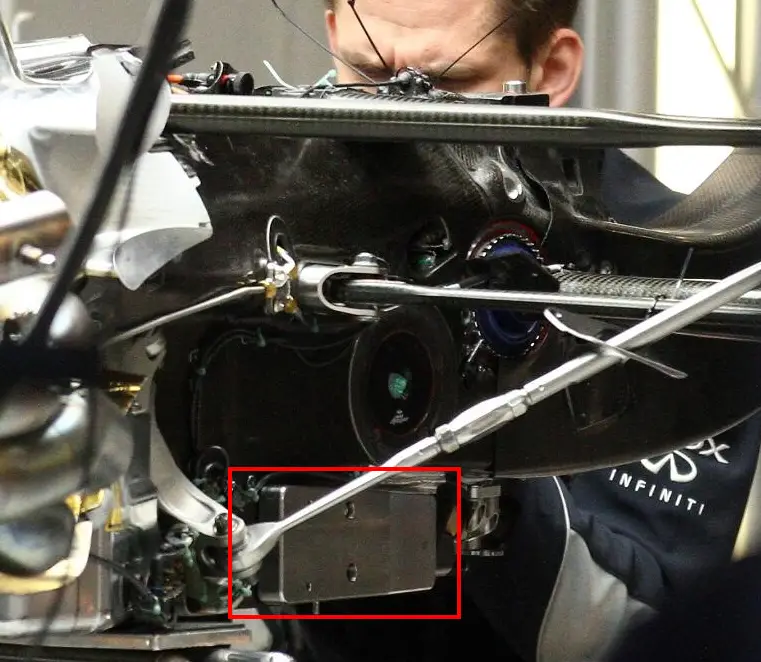The world of Formula 1 cars racing is synonymous with speed, power, and high-tech machines. With some of the most advanced engineering and design techniques in the world, Formula 1 cars are capable of reaching incredible speeds and performing incredible feats of agility.
But have you ever wondered what an F1 Car Weight is? In the high-stakes world of motorsports, even the slightest weight difference can mean the difference between victory and defeat. In this article, we’ll take a closer look at the weight of these incredible machines, and explore the impact that weight has on their performance and racing success.
From the engines to the tires, we’ll delve into the details of Formula 1 car design and discover the secrets behind their incredible speed and agility.
So buckle up and get ready to explore the fascinating world of Formula 1 racing!
F1 Car are Much Heavier Than You Think

The FIA, the governing body of Formula 1, sets a minimum weight limit. This is a non negotiable value for the cars that teams have to follow. This limit is intended to ensure fair competition and prevent teams from making their cars too light. This would give them an unfair advantage.
The minimum weight limit for 2023 is 798 kg (1,759 lbs.). The value includes the driver, the car and the dry-weather tires, but not the fuel. This limit was increased by 3 kg from the original 795 kg limit that teams struggled to meet.
The FIA also plans to reduce the weight by 2 kg in 2024. This plan was scrapped to accommodate heavier tires and new electronic devices in the car.
The minimum weight limit is measured after the race, when the car has used most of its fuel. The fuel capacity of a Formula 1 car is 110 kg. At the race start with a full fuel load, the car will weigh at least 908 kg (2,002 lbs.).
Assuming it meets the minimum weight limit. Teams may choose to run with less than 110 kg of fuel depending on the track and their strategy.
There is no upper limit for the weight of a Formula 1 car. It is however undesirable to be overweight. Increasing the weight makes the car slower, as it reduces acceleration, top speed and cornering ability. Teams aim to get as close to the minimum weight limit as possible, or even below it if they can.
F1 Car Weight – Minimum Weight Limit
This chapter explores the concept of the minimum weight limit in F1 cars, shedding light on the implications, challenges, and the constant quest for the ideal balance between speed and safety.
Setting the Bar: The Minimum Weight Limit of F1 Cars
F1 Car Weight – Regulatory Mandates
The Fédération Internationale de l’Automobile (FIA), the governing body of Formula 1, establishes strict regulations to ensure fair competition and prioritize safety. One such regulation is the imposition of a minimum weight limit for F1 cars.
F1 Car Weight – Dynamic Nature of Regulations
The minimum weight limit is not a static parameter but evolves in response to technological advancements, safety considerations, and shifts in the overall landscape of the sport. The FIA regularly reviews and adjusts these limits to align with the changing dynamics of Formula 1.
Factors Influencing Minimum F1 Car Weight
F1 Car Weight – Safety Imperatives
The foremost consideration behind setting a minimum weight limit is driver safety. The structural integrity of the car, especially in the event of a collision or impact, is closely tied to its weight. The minimum weight serves as a safeguard to ensure that cars are built with robust materials and constructions.
F1 Car Weight – Technology Integration
Advancements in technology, particularly in power units and aerodynamics, influence the weight of F1 cars. Hybrid power units, energy recovery systems, and intricate aerodynamic components add both performance capabilities and weight to the overall package.
Implications for Teams and Engineers
F1 Car Weight – Performance Optimization
Teams face the ongoing challenge of optimizing the performance of the car within the constraints of the minimum weight limit. Striking the right balance between safety features, aerodynamics, and power unit efficiency is a continuous engineering puzzle.
F1 Car Weight – Weight Distribution Challenges
The placement of components within the car is crucial. Teams must carefully distribute weight to achieve an optimal center of gravity, ensuring stability and responsiveness on the track.
Adapting to Change: Technological Innovation
F1 Car Weight – Materials Science Breakthroughs
As technology advances, so does the exploration of innovative materials that can maintain structural integrity while minimizing weight. Carbon fiber and other composite materials play a pivotal role in achieving this delicate balance.
F1 Car Weight – Continuous Research and Development
Teams invest heavily in research and development to explore new materials, manufacturing techniques, and design philosophies. The goal is to push the boundaries of performance without compromising safety or exceeding the minimum weight limit.
F1 Car Weight – Heavier Over Time

A discernible trend has emerged over time – F1 cars have become progressively heavier. In this chapter, we delve into the factors contributing to the increased weight of Formula 1 cars and the implications for racing dynamics.
Historical Perspective: Featherweight Beginnings
Origins of Lightweight F1 Car Design
Historically, Formula 1 cars were celebrated for their featherweight construction. The pursuit of speed and agility led to the extensive use of lightweight materials, such as aluminum and magnesium, in the chassis and components.
F1 Car Weight – Regulatory Influences
In the early years, regulations imposed limitations on engine power, fostering a focus on minimizing weight to enhance overall performance. Lightweight designs were synonymous with nimble handling and faster lap times.
The Shift Towards Heftier F1 Cars
F1 Car Weight – Safety Prioritization
In recent decades, an increased emphasis on driver safety has been a driving force behind the gradual increase in F1 car weight. Safety features, such as the introduction of the Halo cockpit protection system and reinforced chassis, contribute to the overall mass of the car.
F1 Car Weight – Hybrid Power Units
The adoption of hybrid power units marked a significant shift in F1 technology. While contributing to enhanced energy efficiency, these power units come with added weight due to the inclusion of complex components like energy recovery systems and batteries.
F1 Car Weight – Aerodynamic Complexity
Advancements in aerodynamics, aimed at maximizing downforce and minimizing drag, have led to the incorporation of intricate wing designs and additional aerodynamic components. These additions, while crucial for performance, contribute to the overall weight of the car.
Implications for Racing Dynamics
F1 Car Weight – Balancing Act
As Formula 1 cars have gained weight, teams face a delicate balancing act between safety, performance, and agility. The challenge lies in optimizing the car’s setup to maintain high-speed capabilities while adapting to the increased mass.
F1 Car Weight – Tire Wear and Fuel Consumption
Heavier cars place greater demands on tires and fuel consumption. Teams must carefully manage these factors during races, considering the impact of increased weight on tire degradation and overall race strategy.
The Constant Quest for F1 Car Performance
F1 Car Weight – Technological Innovation
Despite the trend towards heftier machines, Formula 1 remains a hotbed of technological innovation. Teams continuously explore ways to offset weight increases through materials science, advanced manufacturing techniques, and strategic design.
F1 Car Weight – Regulatory Landscape
The sport’s governing body, the Fédération Internationale de l’Automobile (FIA), plays a crucial role in shaping the regulatory landscape. Future rule changes and technological developments may influence the trajectory of F1 car weights.
F1 Car Weight – Ballast

If a car is under the weight limit, teams add extra weight to it in the form of ballast. Ballast is usually made of tungsten or steel. It can be placed anywhere on the car to improve its balance and handling.
For example, ballast can be added to the front or rear of the car to adjust its weight distribution, or to the bottom of the car to lower its center of gravity.
Ballast can also be used to compensate for heavier drivers, who may otherwise be at a disadvantage compared to lighter drivers.
Until 2019, the driver’s weight was not included in the minimum weight limit, meaning that heavier drivers had less ballast to play with and had to compromise on performance or comfort.
However, since 2019, the FIA has introduced a separate minimum weight limit for the driver and his seat of 80 kg (176 lbs.), which means that heavier drivers are no longer penalized and lighter drivers have to add ballast to their seat.
Why Does F1 have a Minimum Weight?
Formula 1 imposes a minimum weight for cars primarily for safety and competitive reasons. The minimum weight serves as a regulatory measure set by the sport’s governing body, the Fédération Internationale de l’Automobile (FIA). Several key reasons underpin the establishment of a minimum weight requirement in Formula 1:
Structural Integrity and Safety
Ensuring the structural integrity of the car is paramount in Formula 1. The minimum weight limit is set to guarantee that teams construct cars with materials and designs that can withstand the intense forces experienced during high-speed races.
This includes factors like crashes, collisions, and aerodynamic loads. A car that is too lightweight may compromise safety in the event of an impact.
Equal Competition
To maintain fair competition among teams, a minimum weight limit prevents a scenario where teams might gain an advantage by building excessively lightweight cars.
Without a minimum weight, teams might be tempted to push the limits of weight reduction, potentially sacrificing safety for a competitive edge.
Balanced Performance
The minimum weight limit helps achieve a balance between different performance aspects of the car. It considers the weight distribution, aerodynamics, and overall handling characteristics. Striking the right balance is crucial for optimal performance on diverse tracks with varying demands.
Integration of Technological Advancements
Formula 1 is a hotbed of technological innovation, with continuous advancements in materials, power units, and aerodynamics. The minimum weight limit adapts to accommodate these technological changes, ensuring that safety remains a priority while allowing teams to push the boundaries of performance.
Prevention of Extreme Weight Reduction
Without a minimum weight requirement, teams might be incentivized to engage in extreme weight reduction practices that could compromise the integrity of the car. The minimum weight limit acts as a safeguard against such practices, promoting a balance between innovation and safety.
Dynamic Nature of the Sport
Formula 1 is a dynamic and evolving sport. The minimum weight limit can be adjusted by the FIA in response to technological advancements, changes in safety standards, or other relevant considerations. This adaptability ensures that the regulations remain relevant and effective over time.
In summary, the minimum weight limit in Formula 1 is a comprehensive regulatory measure that addresses safety concerns, promotes fair competition, and accounts for the continuous evolution of technology within the sport. It stands as a crucial component of the overall framework that governs the construction and performance of Formula 1 cars.
Innovations To Reduce How Much F1 Car Weight
Teams are constantly looking for ways to reduce the weight of their cars and gain an edge over their rivals. They use lightweight materials such as carbon fiber, titanium and magnesium to construct their chassis, bodywork and components.
They also try to optimize every part of their car for efficiency and performance, minimizing any unnecessary or redundant elements.
However, there are some factors that limit how much teams can reduce their car’s weight. One factor is safety:
Formula 1 cars have to comply with strict safety standards and regulations that require them to have certain features such as crash structures, roll bars, fire extinguishers and halo devices. These features add weight to the car but are essential for protecting the driver in case of an accident.
Another factor is reliability: Formula 1 cars have to endure high stresses and strains during a race weekend, which can cause parts to fail or wear out.
Teams have to balance between making their cars light and making them durable enough to last a race distance without breaking down or losing performance.
Q&A
How Much Does an F1 car weigh?
While the entire F1 car should weigh no less than 798kg, the heaviest part of a Formula 1 car is the engine which must weigh a minimum of 150kg
Is There a Weight Limit for F1 drivers?
F1’s minimum weight for drivers is about 176 pounds, but according to the sport’s governing body, that includes the equipment they wear, which can weigh up to 15 pounds. Check out the heights and weights of the 2023 drivers.
Why Does F1 have a Minimum Weight?
The minimum weight limit in Formula 1 is a comprehensive regulatory measure that addresses safety concerns, promotes fair competition, and accounts for the continuous evolution of technology within the sport.
It stands as a crucial component of the overall framework that governs the construction and performance of Formula 1 cars.
What is the Minimum Weight for F1 2024?
Given the challenging conditions experienced at the Qatar Grand Prix that led to some drivers requiring medical attention, a small scoop designed to channel cool air into the cockpit will be incorporated beneath Formula 1 cars starting from the 2024 season. This change has received approval from the F1 Commission.
Nikolas Tombazis, representing the FIA, has revealed a new emergency protocol tailored for extreme weather scenarios. This protocol mandates an increase in the minimum weight of cars, with the additional weight designated for installing supplementary cooling equipment for drivers.
While there’s potential for the elevated minimum weight to be strategically exploited, Tombazis has underscored its singular purpose: driver cooling. He highlighted the impracticality of misusing the added weight, citing the performance challenges faced by drivers in the intense heat of Qatar.
The recent decision by the FIA to enhance driver safety in Formula 1 races is a direct response to the significant health issues encountered by drivers during the Qatar Grand Prix, particularly due to the sweltering conditions. In response, a new regulation has been established to introduce a cooling mechanism beneath the cars, effective from the 2024 season.
How Much Weight F1 Driver Lose in a Race?
Drivers can shed anywhere from 4.4 to 6.6 pounds per race, which equates to 2 to 3 kilograms. Losing such a substantial amount of weight within a mere two hours is notable, with the majority of this weight loss attributed to sweating.
The temperatures inside the car can reach astonishing levels, contributing to the significant amount of perspiration.
Conclusion
The minimum weight limit in Formula 1 serves as a dynamic parameter, reflecting the sport’s commitment to safety and the ever-evolving landscape of technological innovation.
Teams and engineers navigate this intricate terrain, seeking the optimal balance that allows their cars to dance on the razor’s edge of speed and safety. As Formula 1 continues to push the boundaries of what’s possible, the minimum weight limit remains a central figure in the ongoing saga of high-performance racing.

